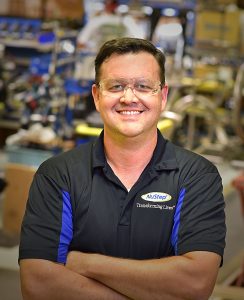NuStep Transforms Lives with Ergonomics
08/11/2016

NuStep’s mission, to “transform lives by improving the health and wellness of its customers,” has been in motion since the 1980s, when Founder Dick Sarns recognized the effect exercise has on managing heart disease. Through research, he learned there was no safe, effective, easy-to-use exercise equipment for cardiac rehabilitation patients. With hard work and determination, the world’s first recumbent cross-trainer was born in 1993.
The low-impact, total-body workout machine is widely used today by individuals with limited mobility (due to an injury or disease) to athletes on the gym floor. Physical therapy centers, medical facilities, gyms, senior centers, and residential homes are some of the locations that receive one of hundreds of units shipped each month.
Each day, NuStep’s skilled workers manufacture the units, each weighing up to 300 pounds, at their facility in Ann Arbor, Michigan. The risk of injury from moving, lifting, assembling, testing, pushing, packaging, and loading thousands of pounds of steel each day is great.

Keith Choat
“We are always looking to make things better, more efficient,” says Keith Choat, Lean Systems Coordinator. Formal lean kaizen events or continuous improvement activities have been a common occurrence in NuStep’s manufacturing plant. However, it wasn’t until Keith attended Humantech’s Applied Industrial Ergonomics seminar and Advanced Ergonomic Design workshop in 2014 that a light bulb went off. “We were missing the ergonomics element. We were always making process and efficiency improvements but not necessarily making the job easier and safer for our people,” says Choat.
“We want our people to go home every night and play with their kids. We don’t want them to get injured,” says Choat. “The training taught me how to identify musculoskeletal disorder risk factors and how to fix them. I was excited to share that knowledge with our team,” he says.
Choat took his new-found knowledge and skills and developed a 30-minute training course for NuStep’s production workers. Learning the principles of ergonomics, how to identify musculoskeletal disorder risk factors, and how to use the Humantech tools to fix jobs enabled the team to improve their high-risk jobs. “The biggest reward I get from driving change, is when employees recognize an opportunity for improvement. When they see an awkward posture and recommend something better and safer, it’s assurance that we’re being proactive,” says Choat.
Since the workshop two years ago, NuStep has improved several dozen jobs. The most dramatic improvement was when the test machine job, located in the service department, was redesigned. Prior to the fix, a worker had to test the functionality of the monitor display while cycling the unit with both hands. “It was excruciating to watch her do it,” says Choat. To test the unit, she had to extend both arms forward and around the unit, as if she were hugging it, grab a pedal, and cycle it back and forth. While cycling, she had to lean back and extend her neck in a flexed posture to view the data on a monitor that was positioned too high and angled 25 degrees outside of the optimal viewing distance.
To improve her posture and the task, handles from scrapped product were fabricated and mounted below the monitor. The monitor was also repositioned and angled appropriately. These changes improved her posture and closed the distance between her and her work.
Additional changes have been made; large, heavy items were moved from the floor to in-house fabricated stands to eliminate extreme bending, and overhead hoists were installed to move heavy items that were previously lifted manually.
Having tackled the “low-hanging fruit,” the company is prepared to make more complex improvements. Redesigning the product shipping box is first in the queue. Closing and opening a 6-foot by 5-foot cardboard box is difficult for most, especially for shorter individuals. The goal of the improvement is to make the packing and unpacking processes easier for both the NuStep worker and the customer.
Sustaining the ergonomics process has come easy for Nustep. “Our mission statement is to transform lives by improving health and wellness for our customers. We also need to transform the lives of our staff—in the office and on the plant floor,” says Choat. “Humantech’s training opened our eyes to safety and ergonomics and made us wonder, ‘Why haven’t we been doing this all along?’”






